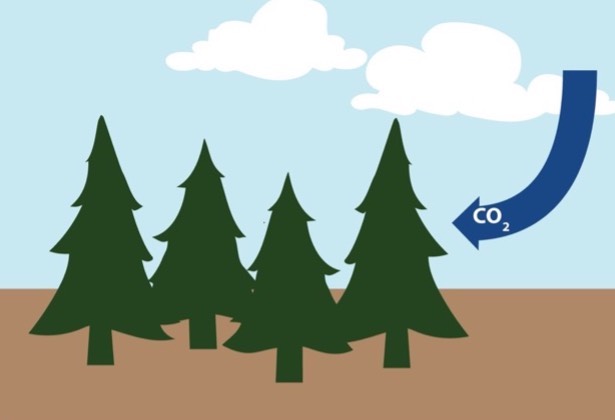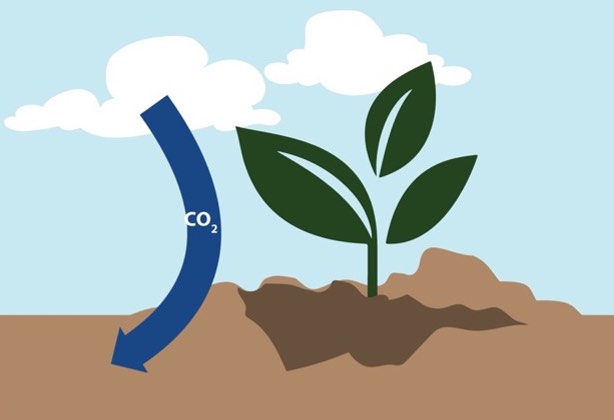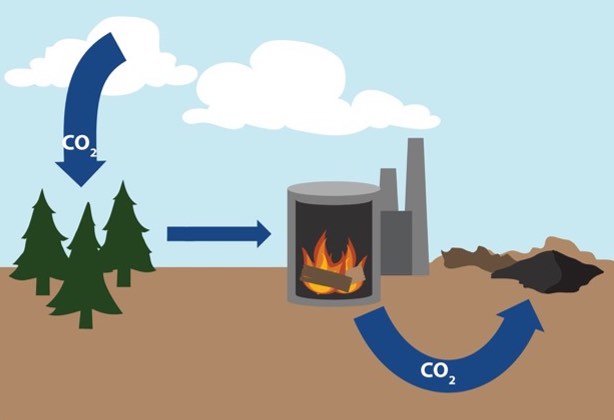 Nature-Based Carbon Dioxide Removal🔗
Nature-Based Carbon Dioxide Removal🔗
Encourage the expansion of forests (afforestation), the restoration of former or degraded forests (reforestation), the implementation of agricultural practices that capture carbon, and the production of biochar. These nature-based methods can remove carbon dioxide from the atmosphere and store it in plants and soils. However, this carbon may be released again if the land is altered, whether through deliberate actions like farming or accidental events like wildfires.
Examples🔗
- Government policies, incentives, and funding to identify available land, plant trees, and manage forests.
- Business, land owner, and public support for large scale tree planting.
- Carbon markets that incentivise farmers to implement agricultural soil carbon sequestration practices such as cover cropping and crop rotation.
- Manufacturing and using biochar as a soil amendment.
Nature-Based Carbon Dioxide Removal Methods🔗
The following methods of nature-based CO2 removal can be explored in the En-ROADS simulator:
 |
 |
| Afforestation and reforestation. As trees grow, they draw carbon out of the air, which reduces the concentration of carbon dioxide. The CO2 is then stored in living biomass. | Agricultural soil carbon sequestration involves using agricultural practices which enhance soil carbon (such as no-till agriculture and preventing overgrazing). |
 |
|
| Biochar is biomass (e.g., from trees) that has been made into charcoal via pyrolysis, and is then buried to retain the carbon. |
Big Messages🔗
Afforestation and reforestation have the potential to pull significant amounts of carbon dioxide out of the atmosphere, but land availability and other effects should be considered. It would take an immense amount of land to make a large impact on temperature change.
Carbon stored in trees and soils is vulnerable to future release due to natural disturbances (e.g., wildfires) or changes in land management (e.g., overgrazing or deforestation).
Key Dynamics🔗
Impact. Growing more trees boosts global removal of CO2 from the atmosphere, as photosynthesis pulls carbon into biomass and soils. Watch the temperature decrease modestly as a result.
Delay. It takes decades for newly planted trees to remove enough carbon for it to be a significant source of carbon removals.
Reversibility. Trees are susceptible to fire, insects, and weather-related damage, not to mention future harvests; all of which lead to carbon emissions as a result of combustion and decay.
Scale compared to emissions from energy. The amount of carbon that additional trees can pull out of the atmosphere is overshadowed by the enormous amount of carbon dioxide released through fossil fuel combustion.
Land needed. View the graphs “Land for Growing CO2 Removal Biomass” and “Land for Farming with CO2 Removal” and note the total amount of land area that all the approaches might require.
Potential Co-Benefits of Nature-Based Carbon Dioxide Removal🔗
- New forests can create new ecosystems and protect existing wildlife habitats, biodiversity, and ecosystem services.
- Larger and healthier tree canopies in cities reduce urban heat island effects and energy needed for heating and cooling.
- Jobs are created in tree planting, care, and maintenance.
- Nature-based carbon removal approaches like agricultural soil carbon sequestration can help improve landholder and farmer profits in some cases through carbon markets.
- Some agricultural soil carbon sequestration methods such as cover crops, and amending soil with biochar, could improve soil health.
Equity Considerations🔗
- Afforestation entails shifting large areas of land to forest. This can sometimes result in monocultures of trees that are all the same age, which does not contribute to healthy biodiversity as much as natural forests.
- Large shifts in land can compromise historical land access, so involving low-income and minority communities, including Indigenous peoples, in the process of policy development and implementation is essential.
- Harvesting feedstocks for biochar production may compete with other uses, such as food production or habitat preservation, and could have negative environmental or social impacts if not managed sustainably.
Slider Settings🔗
Moving the main Nature-Based Carbon Dioxide Removal slider changes the amount of carbon removed by three methods: afforestation and reforestation, agricultural soil carbon sequestration, and biochar.
| status quo | low growth | medium growth | high growth | |
|---|---|---|---|---|
| Percent of max potential | 0% to +15% | +15% to +40% | +40% to +70% | +70% to +100% |
Afforestation and reforestation: The “Percent available land used for afforestation and reforestation” slider changes the amount of available land that is used to grow new forests. 100% would mean that 550 million hectares (Mha) of land is covered in forests. 550 Mha represents approximately 16% of current grassland area, 6% of all land (including desert and tundra) that is not currently forest, and about 80% of the difference in forest area back in 1850 until now (i.e., there is 680 Mha less forest area today than in 1850).1
Agricultural soil carbon sequestration and biochar: The default settings for the maximum potential of agricultural soil carbon sequestration and biochar (“% of max potential”) are sourced from the midpoint of the ranges of the 2018 "Greenhouse gas removal" report by the Royal Society (Table 2, Chapter 2). For example, moving the simulator’s biochar slider to “100% of max potential” increases removals up to 3.5 Gton/year, which was taken from the report’s range of 2-5 Gtons/year. For higher removal, one can adjust the “Carbon dioxide removal maximum” settings within the Assumptions view, up to the highest end of the range sourced from the report. For example, the biochar maximum can be increased to 5 Gtons/year.
Model Structure🔗
The methods of nature-based CO2 removal included are modeled independently. They each vary in their maximum sequestration potential, the year they might start to scale up, how long it takes them to store carbon, and the carbon leakage rate over time (stored carbon is not always permanent).
Afforestation and reforestation: Forests are dynamic and result in both carbon removals and emissions. Notice in the “CO2 Removals from Afforestation and Reforestation” graph that net CO2 removals are lower than total removals due to the carbon loss from decay and forest fires in older or unhealthy forests. For higher removals, one can adjust the “Max available land for afforestation and reforestation” under the “Afforestation and reforestation” settings within the Assumptions view. For example, to explore planting a trillion trees, increase the slider “Max available land for afforestation and reforestation” to 900 Mha (with an average tree spacing consistent with the midpoint value from Russell (2020)).
Case Studies🔗
New York City, USA: Increasing urban tree density by 343 trees per square kilometer was shown to reduce the rate of childhood asthma by 29% in New York City.2
FAQs🔗
Why is planting trees (afforestation and reforestation) not more impactful?
Where can I learn more about the different Nature-Based CDR types? Follow the links to find detailed fact sheets on these CDR types:
Why isn’t BECCS included under Nature-Based CDR? Bioenergy with carbon capture and storage (BECCS) is both a possible source of energy and a carbon dioxide removal (CDR) method. For consistency with coal and gas CCS, it appears in the advanced view of its respective energy source slider (Bioenergy), rather than under Nature-Based CDR.
Please visit support.climateinteractive.org for additional inquiries and support.
Footnotes
[1]: Hurtt, G. C., L. Chini, R. Sahajpal, S. Frolking, B. L. Bodirsky, K. Calvin, J. C. Doelman, J. Fisk, S. Fujimori, K. K. Goldewijk, T. Hasegawa, P. Havlik, A. Heinimann, F. Humpenöder, J. Jungclaus, Jed Kaplan, J. Kennedy, T. Kristzin, D. Lawrence, P. Lawrence, L. Ma, O. Mertz, J. Pongratz, A. Popp, B. Poulter, K. Riahi, E. Shevliakova, E. Stehfest, P. Thornton, F. N. Tubiello, D. P. van Vuuren, X. Zhang (2020). Harmonization of Global Land-Use Change and Management for the Period 850-2100 (LUH2) for CMIP6. Geoscientific Model Development Discussions.
[2]: Lovasi, G. S., Quinn, J. W., Neckerman, K. M., Perzanowski, M. S., & Rundle, A. (2008). Children living in areas with more street trees have lower prevalence of asthma. Journal of Epidemiology & Community Health, 62(7), 647–649.
